Perspectives on the Development of Technologies for Hydrogen as a Carrier of Sustainable Energy
Abstract
:1. Introduction
2. Hydrogen Applications
2.1. Transport Applications
2.2. Fuel Cells
2.3. Hydrogen Applications in Industry
2.4. Hydrogen as an Energy Carrier
3. Hydrogen Production
3.1. Electrolysis
3.2. Natural Gas Processing
3.3. Photoelectrolysis
3.4. Renewables
| Method | Chemical Reactions | Advantages | Drawbacks |
|---|---|---|---|
| Methanol steam reforming | CH3OH + H2O = CO2 + H2 | High hydrogen yield, low CO content, and low operating temperatures | Requires external energy supply |
| Partial oxidation of methanol | CH3OH + 1/2O2 = CO2 + 2H2 | Fast start-up and response; no thermal management | Low hydrogen yield, high temperatures, and high CO content |
| Autothermal methanol reforming | CH3OH + αO2 +(1 − 2α)H2O = CO2 +(3 − 2α)H2 | Simplified thermal management, low temperatures, and fast start-up | Low hydrogen yield; requires control to balance exothermic and endothermic processes |
4. Supply Chains
- The step of hydrogen production, consisting of different sub-steps depending on the used feedstock;
- The step of hydrogen transportation, related to its supply to the zones of clients;
- The step of the final use of hydrogen, where it is plugged into the vehicle tanks for useful exploitation.
4.1. General Impact on Environment TEIt, [/d]
- Total environmental impact due to the IHSC operation during the whole life cycle .
- Total greenhouse emissions from hydrogen production .
- Total greenhouse emissions from diesel production .
- ETTt Environmental impact from the transportation of feedstocks and final product, including diesel
- Emissions released during waste utilization, resulting from hydrogen production during each time period .
- Emissions resulting from the use of hydrogen as fuel .
4.2. Total Costs THCt, [$/y]
- Total annual costs for the IHSC .
- Total investment costs for production capacity of the IHSC compared to the operation and redemption of the facility per year .
- Operational costs for hydrogen production .
- Operational costs for utilization of waste from hydrogen production .
- Total investment costs for commercial capacity of the IHSC compared to the operation and redemption of the hydrogen facility per year .
- Operational costs at the final sales of hydrogen .
- Total transportation costs in the IHSC .
- Carbon tax, charged according to the total sum of generated energy at the work of IHSC .
- Governmental incentives for the production and use of hydrogen .
- Total value of the by-products .
4.3. Social Estimate for IHSC [Number of Jobs/y]
- Number of jobs created during construction of the hydrogen facility.
- Number of jobs created during the operation of the hydrogen facility.
- Number of jobs created during the installment of the charging stations.
- Number of jobs created during operation of the charging stations.
4.4. Input Data for the Supply Chain
- The territorial distribution and hydrogen demand for transport;
- The potential localization of the enterprises for hydrogen production in the studied region;
- The potential feedstock for the region;
- Data about the emissions for each type of hydrogen production;
- Data about the operational costs for each type of hydrogen manufacturing;
- The potential localization of the charging stations.
5. Hydrogen Storage
6. Perspectives for Hydrogen-Based Economy
7. Discussion
Author Contributions
Funding
Institutional Review Board Statement
Informed Consent Statement
Data Availability Statement
Acknowledgments
Conflicts of Interest
References
- Winter, C.-J. Into the hydrogen energy economy—Milestones. Int. J. Hydrogen Energy 2005, 30, 681–685. [Google Scholar] [CrossRef]
- Verhelst, S.; Wallner, T. Hydrogen-fueled internal combustion engines. Prog. Energy Combust. Sci. 2009, 35, 490–527. [Google Scholar] [CrossRef]
- Xu, X.; Zhou, Q.; Yu, D. The future of hydrogen energy: Bio-hydrogen production technology. Int. J. Hydrogen Energy 2022, 47, 33677–33698. [Google Scholar] [CrossRef]
- European Commission. A Hydrogen Strategy for a Climate-Neutral Europe, Communication from the Commission to the European Parliament, the Council, the European Economic and Social Committee and the Committee of the Regions; COM(2020) 301 final; European Commission: Brussels, Belgium, 2020. [Google Scholar]
- Reitz, R.D.; Ogawa, H.; Payri, R.; Fansler, T.; Kokjohn, S.; Moriyoshi, Y.; Agarwal, A.; Arcoumanis, D.; Assanis, D.; Bae, C.; et al. IJER editorial: The future of the internal combustion engine. Int. J. Engine Res. 2020, 21, 3–10. [Google Scholar] [CrossRef]
- Hocking, M.B. Fermentation processes. In Modern Chemical Technology and Emission Control; Springer: Berlin/Heidelberg, Germany, 1985; pp. 338–377. [Google Scholar] [CrossRef]
- Ranasinghe, K.; Guan, K.; Gardi, A.; Sabatini, R. Review of advanced low-emission technologies for sustainable aviation. Energy 2019, 188, 115945. [Google Scholar] [CrossRef]
- Saias, C.A.; Roumeliotis, I.; Goulos, I.; Pachidis, V.; Bacic, M. Assessment of hydrogen fuel for rotorcraft applications. Int. J. Hydrogen Energy 2022, 47, 32655–32668. [Google Scholar] [CrossRef]
- Baroutaji, A.; Wilberforce, T.; Ramadan, M.; Olabi, A.G. Comprehensive investigation on hydrogen and fuel cell technology in the aviation and aerospace sectors. Renew. Sustain. Energy Rev. 2019, 106, 31–40. [Google Scholar] [CrossRef]
- Hua, T.Q.; Ahluwalia, R.K.; Peng, J.K.; Kromer, M.; Lasher, S.; McKenney, K.; Law, K.; Sinha, J. Technical assessment of compressed hydrogen storage tank systems for automotive applications. Int. J. Hydrogen Energy 2011, 36, 3037–3049. [Google Scholar] [CrossRef]
- Barthelemy, H.; Weber, M.; Barbier, F. Hydrogen storage: Recent improvements and industrial perspectives. Int. J. Hydrogen Energy 2017, 42, 7254–7262. [Google Scholar] [CrossRef]
- Aminudin, M.A.; Kamarudin, S.K.; Lim, B.H.; Majilan, E.H.; Masdar, M.S.; Shaari, N. An overview: Current progress on hydrogen fuel cell vehicles. Int. J. Hydrogen Energy 2023, 48, 4371–4388. [Google Scholar] [CrossRef]
- Gurz, M.; Baltacioglu, E.; Hames, Y.; Kaya, K. The meeting of hydrogen and automotive: A review. Int. J. Hydrogen Energy 2017, 42, 23346. [Google Scholar] [CrossRef]
- How Do Fuel Cell Electric Vehicles Work Using Hydrogen? U.S. Department of Energy—Energy Efficiency and Renewable Energy. Available online: https://afdc.energy.gov/vehicles/how-do-fuel-cell-electric-cars-work (accessed on 21 April 2023).
- İnci, M. Future vision of hydrogen fuel cells: A statistical review and research on applications, socio-economic impacts and forecasting prospects. Sustain. Energy Technol. Assess 2022, 53, 102739. [Google Scholar] [CrossRef]
- Fan, L.; Tu, Z.; Chan, S.H. Recent development of hydrogen and fuel cell technologies: A review. Energy Rep. 2021, 7, 8421–8446. Available online: https://www.sciencedirect.com/science/article/pii/S2352484721006053 (accessed on 19 July 2023). [CrossRef]
- IRENA. Hydrogen: A Renewable Energy Perspective; International Renewable Energy Agency: Abu Dhabi, United Arab Emirates, 2019; Available online: https://www.irena.org/-/media/Files/IRENA/Agency/Publication/2019/Sep/IRENA_Hydrogen_2019.pdf?rev=99c1fc338b5149eb846c0d84d633bccd (accessed on 11 May 2023).
- Valera, H.; Agarwal, A.K. Methanol as an Alternative Fuel for Diesel Engines. In Methanol and the Alternate Fuel Economy; Agarwal, A., Gautam, A., Sharma, N., Singh, A., Eds.; Energy, Environment, and Sustainability; Springer: Singapore, 2019; pp. 9–33. [Google Scholar] [CrossRef]
- Zhao, K. A Brief Review of China’s Methanol Vehicle Pilot and Policy; Methanol Institute: Alexandria, VA, USA, 2019; Available online: https://www.methanol.org/wp-content/uploads/2019/03/A-Brief-Review-of-Chinas-Methanol-Vehicle-Pilot-and-Policy-20-March-2019.pdf (accessed on 20 March 2019).
- Injection of Hydrogen into Blast Furnace: Thyssenkrupp Steel Concludes First Test Phase Successfully. Daily Press. Available online: https://www.thyssenkrupp-steel.com/en/newsroom/press-releases/thyssenkrupp-steel-concludes-first-test-phase-successfully.html (accessed on 2 March 2021).
- Sethuraman, N. India’s Tata Steel Begins Hydrogen Gas Injection Trial in Blast Furnace; Reuters: London, UK, 2023; Available online: https://www.reuters.com/business/sustainable-business/indias-tata-steel-begins-hydrogen-gas-injection-trial-blast-furnace-2023-04-24 (accessed on 24 April 2023).
- Development of CO2 Emission Reduction Technology Using Hydrogen in Blast Furnace Steelmaking. Nippon Steel Corporation. Available online: https://www.challenge-zero.jp/en/casestudy/537 (accessed on 17 May 2023).
- Bhandari, R.; Shah, R.R. Hydrogen as energy carrier: Techno-economic assessment of decentralized hydrogen production in Germany. Renew. Energy 2021, 177, 915–931. [Google Scholar] [CrossRef]
- Wahl, J.; Kallo, J. Quantitative valuation of hydrogen blending in European gas grids and its impact on the combustion process of large-bore gas engines. Int. J. Hydrogen Energy 2020, 45, 32534–32546. [Google Scholar] [CrossRef]
- Zhou, D.; Li, T.; Huang, D.; Wu, Y.; Huang, Z.; Xiao, W.; Wang, Q.; Wang, X. The experimentstudy to assess the impact of hydrogen blended natural gas on the tensile properties and damage mechanism of X80 pipeline steel. Int. J. Hydrogen Energy 2021, 46, 7402–7414. [Google Scholar] [CrossRef]
- Wolf, D.E. Hydrogen for Generator Cooling—The Pressure, Purity and Dewpoint Difference. Available online: https://metersolution.com/wp-content/uploads/2013/02/Proton-Energy-systems.pdf (accessed on 11 August 2023).
- Acar, C.; Dincer, I. Selection criteria and ranking for sustainable hydrogen production options. Int. J. Hydrogen Energy 2022, 47, 40118–40137. [Google Scholar] [CrossRef]
- Qureshi, F.; Yusuf, M.; Kamyab, H.; Zaidi, S.; Khalil, M.J.; Khan, M.A.; Alam, M.A.; Masood, F.; Bazli, L.; Chelliapan, S.; et al. Current trends in hydrogen production, storage and applications in India: A review. Sustain. Energy Technol. Assess 2022, 53, 102677. [Google Scholar] [CrossRef]
- Lu, Z.; Zhu, Q.; Zhang, W.; Li, H. Economic operation strategy of integrated hydrogen energy system considering the uncertainty of PV power output. Energy Rep. 2023, 9, 463–471. [Google Scholar] [CrossRef]
- Konstantinopoulos, S.A.; Anastasiadis, A.G.; Vokas, G.A.; Kondylis, G.P.; Polyzakis, A. Optimal management of hydrogen storage in stochastic smart microgrid operation. Int. J. Hydrogen Energy 2018, 43, 490–499. [Google Scholar] [CrossRef]
- Bolat, P.; Thiel, C. Hydrogen supply chain architecture for bottom-up energy systems models. Part 1: Developing pathways. Int. J. Hydrogen Energy 2014, 39, 8881–8897. [Google Scholar] [CrossRef]
- Ni, M.; Leung, M.K.H.; Leung, D.Y.C. Technological development of hydrogen production by solid oxide electrolyzer cell (SOEC). Int. J. Hydrogen Energy 2008, 33, 2337–2354. [Google Scholar] [CrossRef]
- Terlouw, T.; Bauer, C.; McKenna, R.; Mazzotti, M. Large-scale hydrogen production via water electrolysis: A techno-economic and environmental assessment. Energy Environ. Sci. 2022, 15, 3583–3602. [Google Scholar] [CrossRef]
- Vincent, I.; Bessarabov, D. Low cost hydrogen production by anion exchange membrane electrolysis: A review. Renew. Sustain. Energy Rev. 2018, 81, 1690–1704. [Google Scholar] [CrossRef]
- Hodges, A.; Hoang, A.L.; Tsekouras, G.; Wagner, K.; Lee, C.-Y.; Swiegers, G.F.; Wallace, G.G. A high-performance capillary-fed electrolysis cell promises more cost-competitive renewable hydrogen. Nat. Commun. 2022, 13, 1304. [Google Scholar] [CrossRef]
- Song, F.; Zhang, T.; Zhou, D.; Sun, P.; Lu, Z.; Bian, H.; Dang, J.; Gao, H.; Qian, Y.; Li, W.; et al. Charge Transfer of Interfacial Catalysts for Hydrogen Energy. ACS Mater. Lett. 2022, 4, 967–977. [Google Scholar] [CrossRef]
- Liu, T.; Diao, P. Nickel foam supported Cr-doped NiCo2O4/FeOOH nanoneedle arrays as a high-performance bifunctional electrocatalyst for overall water splitting. Nano Res. 2020, 13, 3299–3309. [Google Scholar] [CrossRef]
- Hasan, M.M.; Genç, G. Techno-economic analysis of solar/wind power based hydrogen production. Fuel 2022, 324, 124564. [Google Scholar] [CrossRef]
- Beschkov, V.; Razkazova-Velkova, E.; Martinov, M.; Stefanov, S. Electricity Production from Marine Water by Sulfide-Driven Fuel Cell. Appl. Sci. 2018, 8, 1926. [Google Scholar] [CrossRef]
- Acar, C.; Dincer, I. Hydrogen Production. Compr. Energy Syst. 2018, 3, 1–40. [Google Scholar] [CrossRef]
- Hauch, A.; Ebbesen, S.D.; Jensen, S.H.; Mogensen, M. Highly efficient high temperature electrolysis. J. Mater. Chem. 2008, 18, 2331–2340. [Google Scholar] [CrossRef]
- Osman, A.I.; Deka, T.J.; Baruah, D.C.; Rooney, D.W. Critical challenges in biohydrogen production processes from the organic feedstocks. Biomass Conv. Bioref. 2023, 13, 8383–8401. [Google Scholar] [CrossRef]
- Lee, H.S.; Lee, S.Y.; Yoo, K.; Kim, H.W.; Lee, E.; Im, N.G. Biohydrogen production and purification: Focusing on bioelectrochemical systems. Bioresour. Technol. 2022, 363, 127956. [Google Scholar] [CrossRef]
- Hassan, M.; Fernandez, A.S.; San Martin, I.; Xie, B.; Moran, A. Hydrogen evolution in microbial electrolysis cells treating landfill leachate: Dynamics of anodic biofilm. Int. J. Hydrogen Energy 2018, 43, 13051–13063. [Google Scholar] [CrossRef]
- Call, D.F.; Wagner, R.C.; Logan, B.E. Hydrogen Production by Geobacter Species and a Mixed Consortium in a Microbial Electrolysis Cell. Appl. Environ. Microbiol. 2009, 75, 7579–7587. [Google Scholar] [CrossRef]
- Escapa, A.; Mateos, R.; Martínez, E.J.; Blanes, J. Microbial electrolysis cells: An emerging technology for wastewater treatment and energy recovery. From laboratory to pilot plant and beyond. Renew. Sustain. Energy Rev. 2016, 55, 942–956. [Google Scholar] [CrossRef]
- Manish, S.; Banerjee, R. Comparison of bio-hydrogen production processes. Int. J. Hydrogen Energy 2008, 33, 279–286. [Google Scholar] [CrossRef]
- Banu, A.; Bicer, Y. Review on COx-free hydrogen from methane cracking: Catalysts, solar energy integration and applications. Energy Convers. Manag. X 2021, 12, 100117. [Google Scholar] [CrossRef]
- Muto, T.; Asahara, M.; Miyasaka, T.; Asato, K.; Uehara, T.; Koshi, M. Methane pyrolysis characteristics for the practical application of hydrogen production system using permalloy plate catalyst. Chem. Eng. Sci 2022, 237, 117931. [Google Scholar] [CrossRef]
- Su, B.; Wang, Y.; Xu, Z.; Han, W.; Jin, H.; Wang, H. Novel ways for hydrogen production based on methane steam and dry reforming integrated with carbon capture. Energy Convers. Manag. 2022, 270, 116199. [Google Scholar] [CrossRef]
- Park, M.J.; Kim, H.M.; Gu, Y.J.; Jeong, D.W. Optimization of biogas-reforming conditions considering carbon formation, hydrogen production, and energy efficiencies. Energy 2023, 265, 126273. [Google Scholar] [CrossRef]
- Levikhin, A.A.; Boryaev, A.A. Energy-saving, environmentally friendly production of hydrogen from the hydrocarbon feed. Sustain. Energy Technol. Assess 2022, 54, 102876. [Google Scholar] [CrossRef]
- Van de Krol, R.; Grätzel, M. Photoelectrochemical Hydrogen Production; Springer: New York, NY, USA; Dordrecht, The Netherlands; Heidelberg, Germany; London, UK, 2012; Volume 1, pp. 3–12. Available online: https://link.springer.com/book/10.1007/978-1-4614-1380-6 (accessed on 19 July 2023).
- Peng, J.; Wang, Y.; Bai, J.; Ma, D.; Zhao, R.; Han, J.; Wang, L. High-efficiency hollow Zn0.98Cu0.02Se/ZnS/ZnTiO3 photocatalyst for hydrogen production application. Fuel 2022, 325, 124937. [Google Scholar] [CrossRef]
- Karayel, G.K.; Javani, N.; Dincer, I. Hydropower energy for green hydrogen production in Turkey. Int. J. Hydrogen Energy 2023, 48, 22806–22817. [Google Scholar] [CrossRef]
- Luo, Z.; Wang, X.; Wen, H.; Pei, A. Hydrogen production from offshore wind power in South China. Int. J. Hydrogen Energy 2022, 47, 24558–24568. [Google Scholar] [CrossRef]
- Raab, M.; Körner, R.; Dietrich, R.U. Techno-economic assessment of renewable hydrogen production and the influence of grid participation. Int. J. Hydrogen Energy 2022, 47, 26798–26811. [Google Scholar] [CrossRef]
- Shah, M.; Prajapati, M.; Yadav, K.; Sircar, A. A review of the geothermal integrated hydrogen production system as a sustainable way of solving potential fuel shortages. J. Clean. Prod. 2022, 380, 135001. [Google Scholar] [CrossRef]
- Damyanova, S.; Pawelec, B.; Arishtirova, K.; Fierro, J.L.G. Ni-based catalysts for reforming of methane with CO2. Int. J. Hydrogen Energy 2012, 37, 15966–15975. [Google Scholar] [CrossRef]
- Ji, M.; Wang, J. Review and comparison of various hydrogen production methods based on costs and life cycle impact assessment indicators. Int. J. Hydrogen Energy 2021, 46, 38612–38635. [Google Scholar] [CrossRef]
- Chantawan, N.; Moungprayoon, A.; Lunprom, S.; Reungsang, A.; Salakkam, A. High-solid dark fermentation of cassava pulp and cassava processing wastewater for hydrogen production. Int. J. Hydrogen Energy 2022, 47, 40672–40682. [Google Scholar] [CrossRef]
- Chen, W.; Li, T.; Ren, Y.; Wang, J.; Chen, H.; Wang, Q. Biological hydrogen with industrial potential: Improvement and prospection in biohydrogen production. J. Clean. Prod. 2023, 387, 135777. [Google Scholar] [CrossRef]
- Chittibabu, G.; Nath, K.; Das, D. Feasibility studies on the fermentative hydrogen production by recombinant Escherichia coli BL-21. Process Biochem. 2006, 41, 682–688. [Google Scholar] [CrossRef]
- Mei, D.; Qiu, X.; Liu, H.; Wu, Q.; Yu, S.; Xu, L.; Zuo, T.; Wang, Y. Progress on methanol reforming technologies for highly efficient hydrogen production and applications. Int. J. Hydrogen Energy 2022, 47, 35757–35777. [Google Scholar] [CrossRef]
- Kulprathipanja, A.; Falconer, J.L. Partial oxidation of methanol for hydrogen production using ITO/Al2O3 nanoparticle catalysts. Appl. Catal. A Gen. 2004, 261, 77–86. [Google Scholar] [CrossRef]
- Gao, F.; Zhan, H.; Zeng, Z.Y. A methanol autothermal reforming system for the enhanced hydrogen production: Process simulation and thermodynamic optimization. Int. J. Hydrogen Energy 2023, 48, 1758–1772. [Google Scholar] [CrossRef]
- Aziz, M.; Wijayanta, A.T.; Nandiyanto, A.B.D. Ammonia as Effective Hydrogen Storage: A Review on Production, Storage and Utilization. Energies 2020, 13, 3062. [Google Scholar] [CrossRef]
- Kurtz, J.; Sprik, S.; Bradley, T.H. Review of transportation hydrogen infrastructure performance and reliability. Int. J. Hydrogen Energy 2019, 44, 12010–12023. [Google Scholar] [CrossRef]
- Ganev, E.; Ivanov, B.; Vaklieva-Bancheva, N.; Kirilova, E.; Dzhelil, Y. A Multi-Objective Approach toward Optimal Design of Sustainable Integrated Biodiesel/Diesel Supply Chain Based on First- and Second-Generation Feedstock with Solid Waste Use. Energies 2021, 14, 2261. [Google Scholar] [CrossRef]
- Yang, Y.; Tong, L.; Yin, S.; Liu, Y.; Wang, L.; Qiu, Y.; Ding, Y. Status and challenges of applications and industry chain technologies of hydrogen in the context of carbon neutrality. J. Clean. Prod. 2022, 376, 134347. [Google Scholar] [CrossRef]
- Midilli, A.; Kucuk, H.; Topal, M.E.; Akbulut, U.; Dincer, I. A comprehensive review on hydrogen production from coal gasification: Challenges and Opportunities. Int. J. Hydrogen Energy 2021, 46, 25385–25412. [Google Scholar] [CrossRef]
- Chi, J.; Yu, H. Water electrolysis based on renewable energy for hydrogen production. Chin. J. Catal 2018, 39, 390–394. [Google Scholar] [CrossRef]
- Ma, Y.; Wang, X.R.; Li, T.; Zhang, J.; Gao, J.; Sun, Z. Hydrogen and ethanol: Production, storage, and transportation. Int. J. Hydrogen Energy 2021, 46, 27330–27348. [Google Scholar] [CrossRef]
- Singla, S.; Shetti, N.P.; Basu, S.; Mondal, K.; Aminabhavi, T.M. Hydrogen production technologies—membrane based separation, storage and challenges. J. Environ. Manag. 2022, 302, 113963. [Google Scholar] [CrossRef] [PubMed]
- Ganev, E.; Beschkov, V. Optimal synthesis and management of supply chains for production and utilization of biogas. Bul. Chem. Commun. 2022, 54, 205–210. [Google Scholar]
- ARC4 Climate Change 2007: Synthesis Report, Intergovernmental Panel on Climate Change (IPCC), Fourth Assessment Report. 2007. Available online: https://www.ipcc.ch/assessment-report/ar4/ (accessed on 23 February 2022).
- Dillon, A.C.; Heben, M.J. Hydrogen storage using carbon adsorbents: Past, present and future. Appl. Phys. A 2001, 72, 133–142. [Google Scholar] [CrossRef]
- Schlapbach, L.; Zuttel, A. Hydrogen storage for mobile applications. Nature 2001, 414, 353–358. [Google Scholar] [CrossRef]
- Satyapal, S.; Petrovic, J.; Read, C.; Thomas, G.; Ordaz, G. The U.S. Department of Energy’s National Hydrogen Storage Project: Progress towards meeting hydrogen-powered vehicle requirements. Catal. Today 2007, 120, 246–256. [Google Scholar] [CrossRef]
- Bogdanović, B.; Schwickardi, M. Ti-doped alkali metal aluminium hydrides as potential novel reversible hydrogen storage. J. Alloys Compd. 1997, 253–254, 1–9. [Google Scholar] [CrossRef]
- Li, Y.; Yang, R.T. Significantly enhanced hydrogen storage in metal organic frameworks via spillover. J. Am. Chem. Soc. 2006, 128, 726–727. [Google Scholar] [CrossRef] [PubMed]
- Hirscher, M. Handbook of Hydrogen Storage New Materials for Future Energy Storage; Weinheim Wiley-VCH-Verl: Weinheim, Germany, 2010. [Google Scholar] [CrossRef]
- Bigelow, E.; Lewis, M. Conformable Hydrogen Storage Pressure Vessel; Center for Transportation and the Environment: Atlanta, GA, USA, 2018. [Google Scholar] [CrossRef]
- Niaz, S.; Manzoor, T.; Pandith, A.H. Hydrogen storage: Materials, methods and perspectives. Renew. Sustain. Energy Rev. 2015, 50, 457–469. [Google Scholar] [CrossRef]
- Sakintuna, B.; Lamari-Darkrim, F.; Hirscher, M. Metal hydride materials for solid hydrogen storage: A review. Int. J. Hydrogen Energy 2007, 32, 1121–1140. [Google Scholar] [CrossRef]
- Andreasen, A.; Vegge, T.; Pedersen, A.S. Dehydrogenation kinetics of as-received and ball-milled LiAlH4. J. Solid State Chem. 2005, 178, 3672–3678. [Google Scholar] [CrossRef]
- Vajo, J.J.; Skeith, S.L.; Mertens, F. Reversible storage of hydrogen in destabilized LiBH4. J. Phys. Chem. C 2005, 109, 3719–3722. [Google Scholar] [CrossRef] [PubMed]
- Chlopek, K.; Frommen, C.; Leon, A.; Zabara, O.; Fichtner, M. Synthesis and properties of magnesium tetrahydroborate. J. Mater. Chem. 2007, 17, 3496–3503. [Google Scholar] [CrossRef]
- Feaver, A.; Sepehri, S.; Shamberger, P.; Stowe, A.; Autrey, T.; Cao, G. Coherent carbon cryogel—Ammonia borane nanocomposites for H2 storage. J. Phys. Chem. B 2007, 111, 7469–7472. [Google Scholar] [CrossRef]
- Labrousse, J.; Belasfar, K.; Aziz, O.; El Kenz, A.; Benyoussef, A. First principles study of BC7 monolayer compared to graphene as an ultra-high-capacity sheet for hydrogen storage applications. Diam. Relat. Mater 2023, 131, 109523. [Google Scholar] [CrossRef]
- Chen, J.; Dou, S.X.; Liu, H.K. Crystalline Mg2Ni obtained by mechanical alloying. J. Alloys Compd. 1996, 244, 184–189. [Google Scholar] [CrossRef]
- Zaluska, A.; Zaluski, L.; Ström-Olsen, J.O. Synergy of hydrogen sorption in ball-milled hydrides of Mg and Mg2Ni. J. Alloys Compd. 1999, 289, 197–206. [Google Scholar] [CrossRef]
- Imamura, H.; Masanari, K.; Kusuhara, M.; Katsumoto, H.; Sumi, T.; Sakata, Y. High hydrogen storage capacity of nanosized magnesium synthesized by high energy ball-milling. J. Alloys Compd. 2005, 386, 211–216. [Google Scholar] [CrossRef]
- Zhu, M.; Wang, H.; Ouyang, L.Z.; Zeng, M.Q. Composite structure and hydrogen storage properties in Mg-base alloys. Int. J. Hydrogen Energy 2006, 31, 251–257. [Google Scholar] [CrossRef]
- Wiswall, R. Topics in applied physics. Hydrog. Met. II 1978, 29, 209. [Google Scholar]
- Fukai, Y. The Metal–Hydrogen System, Basic Bulk Properties; Springer Series in Materials Science; Springer: Berlin/Heidelberg, Germany, 1993. [Google Scholar]
- Zaluska, A.; Zaluski, L.; Ström–Olsen, J.O. Nanocrystalline magnesium for hydrogen storage. J. Alloys Compd. 1999, 288, 217–225. [Google Scholar] [CrossRef]
- Barkhordarian, G.; Klassen, T.; Bormann, R. Effect of Nb2O5 content on hydrogen reaction kinetics of Mg. J. Alloys Compd. 2004, 364, 242–246. [Google Scholar] [CrossRef]
- Bogdanović, B.; Bohmhammel, K.; Christ, B.; Reiser, A.; Schlichte, K.; Vehlen, R.; Wolf, U. Thermodynamic investigation of the magnesium–hydrogen system. J. Alloys Compd. 1999, 282, 84–92. [Google Scholar] [CrossRef]
- Grochala, W.; Edwards, P.P. Thermal decomposition of the non-interstitial hydrides for the storage and production of hydrogen. Chem. Rev. 2004, 104, 1283–1315. [Google Scholar] [CrossRef] [PubMed]
- Mosquera-Vargas, E.; Tamayo, R.; Morel, M.; Roble, M.; Díaz-Droguett, D.E. Hydrogen storage in purified multi-walled carbon nanotubes: Gas hydrogenation cycles effect on the adsorption kinetics and their performance. Heliyon 2021, 7, 08494. [Google Scholar] [CrossRef]
- Shet, S.P.; Priya, S.S.; Sudhakar, K.; Tahir, M. A review on current trends in potential use of metal-organic framework for hydrogen storage. Int. J. Hydrogen Energy 2021, 46, 11782–11803. [Google Scholar] [CrossRef]
- Cho, S.J.; Song, K.S.; Kim, J.W.; Kim, T.H.; Choo, K. Hydrogen Sorption in HCl-Treated Polyaniline and Polyoyrrole: New Potential Hydrogen Storage Media. Fuel Chem. Div. 2002, 47, 790. [Google Scholar]
- Attia, N.F.; Geckeler, K.E. Polyaniline–Polypyrrole Composites with Enhanced Hydrogen Storage Capacities. Macromol. Rapid Commun. 2013, 34, 931. [Google Scholar] [CrossRef]
- Sevilla, M.; Fuertes, A.B.; Mokaya, R. Preparation and hydrogen storage capacity of highly porous activated carbon materials derived from polythiophene. Int. J. Hydrogen Energy 2011, 36, 15658–15663. [Google Scholar] [CrossRef]
- Germain, J.; Frèchet, J.; Svec, F. Nanoporous, hypercrosslinked polypyrroles: Effect of crosslinking moiety on pore size and selective gas adsorption. Chem. Commun. 2009, 12, 1526–1549. [Google Scholar] [CrossRef] [PubMed]
- Joubert, J.M.; Latroche, M.; Percheron-Guégan, A. Metallic Hydrides II: Materials for Electrochemical Storage. MRS Bull. 2002, 27, 694–698. [Google Scholar] [CrossRef]
- Germain, J.; Fréchet, J.M.J.; Svec, F. Nanoporous Polymers for Hydrogen Storage. Small 2009, 5, 1098. [Google Scholar] [CrossRef] [PubMed]
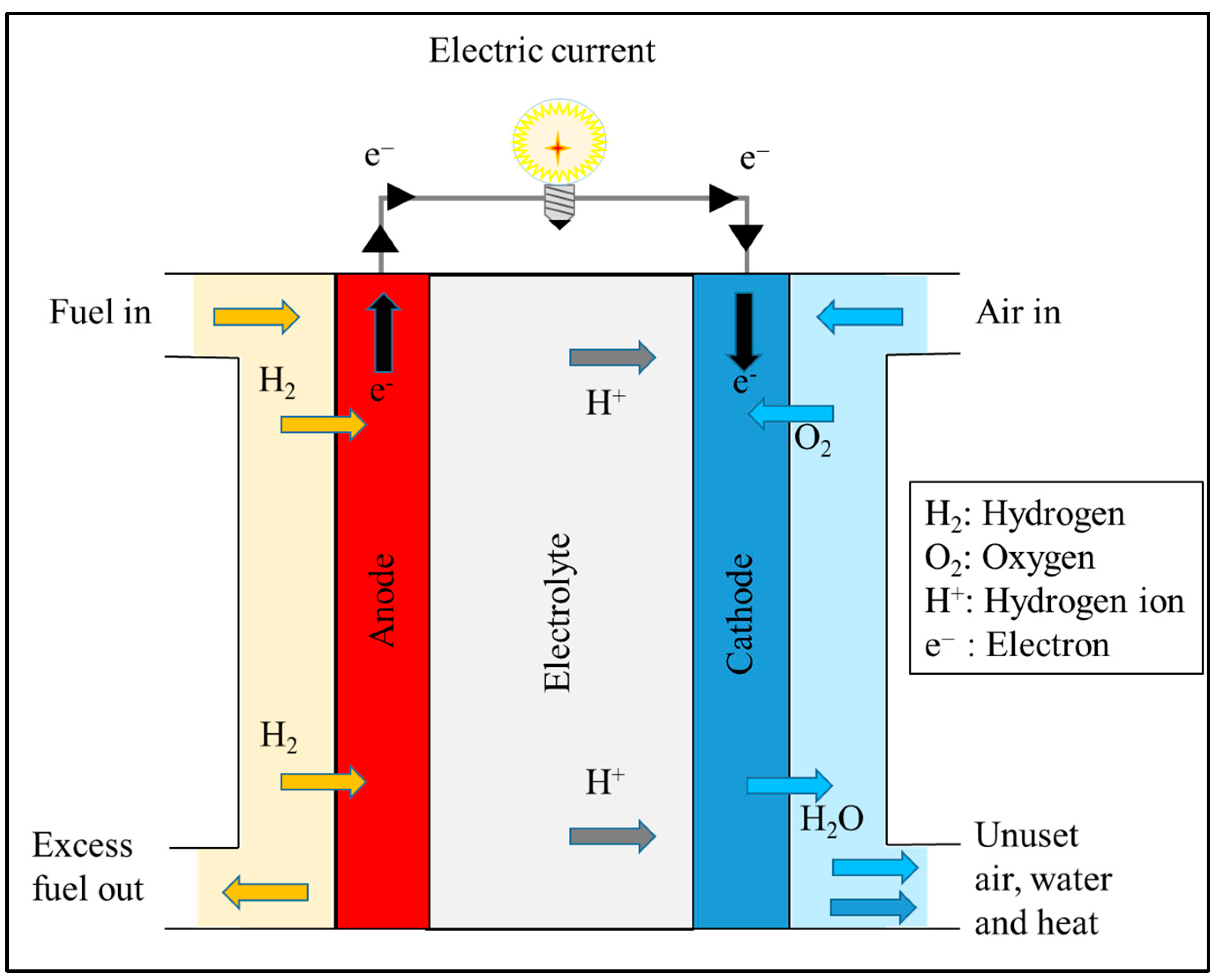

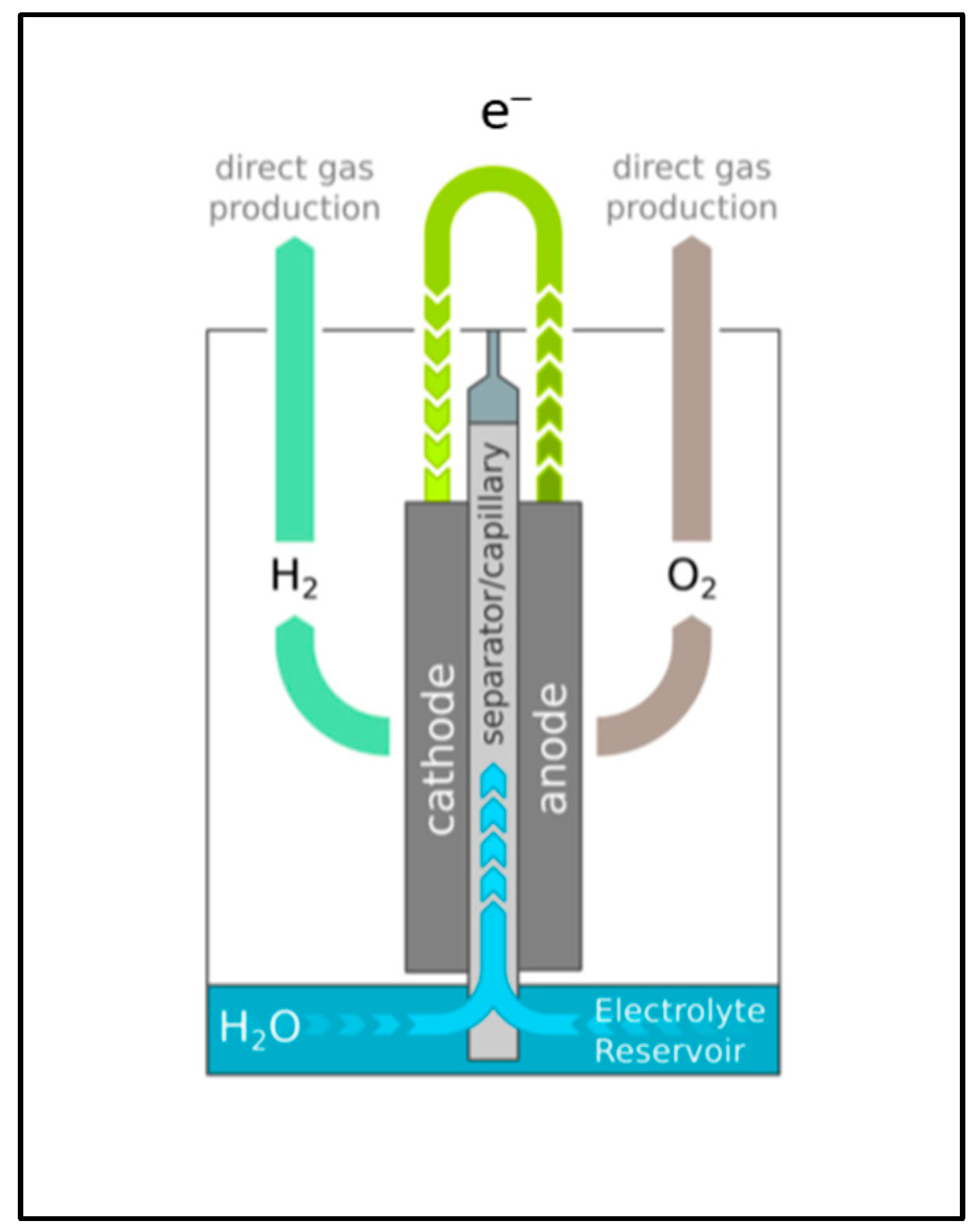
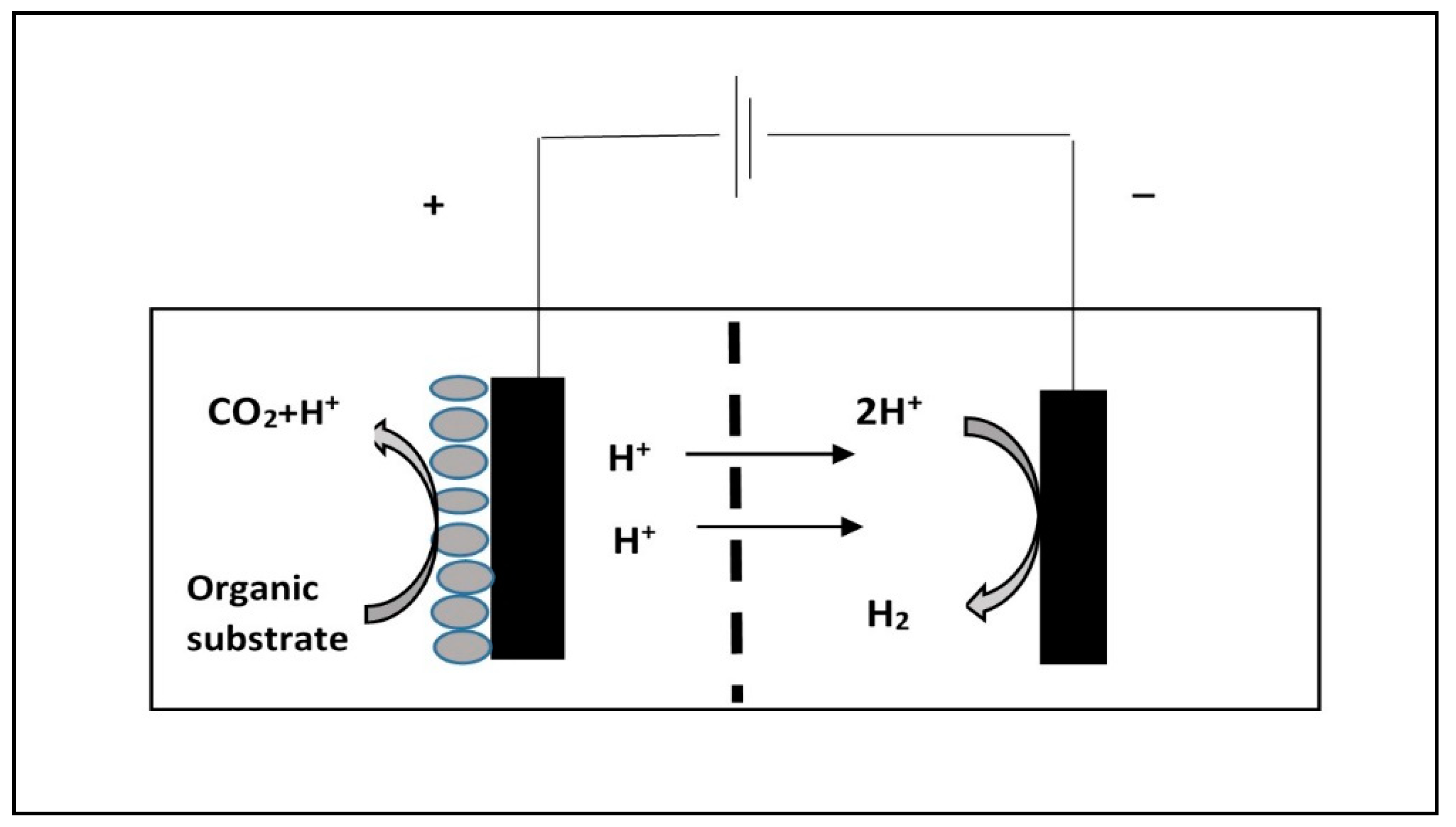

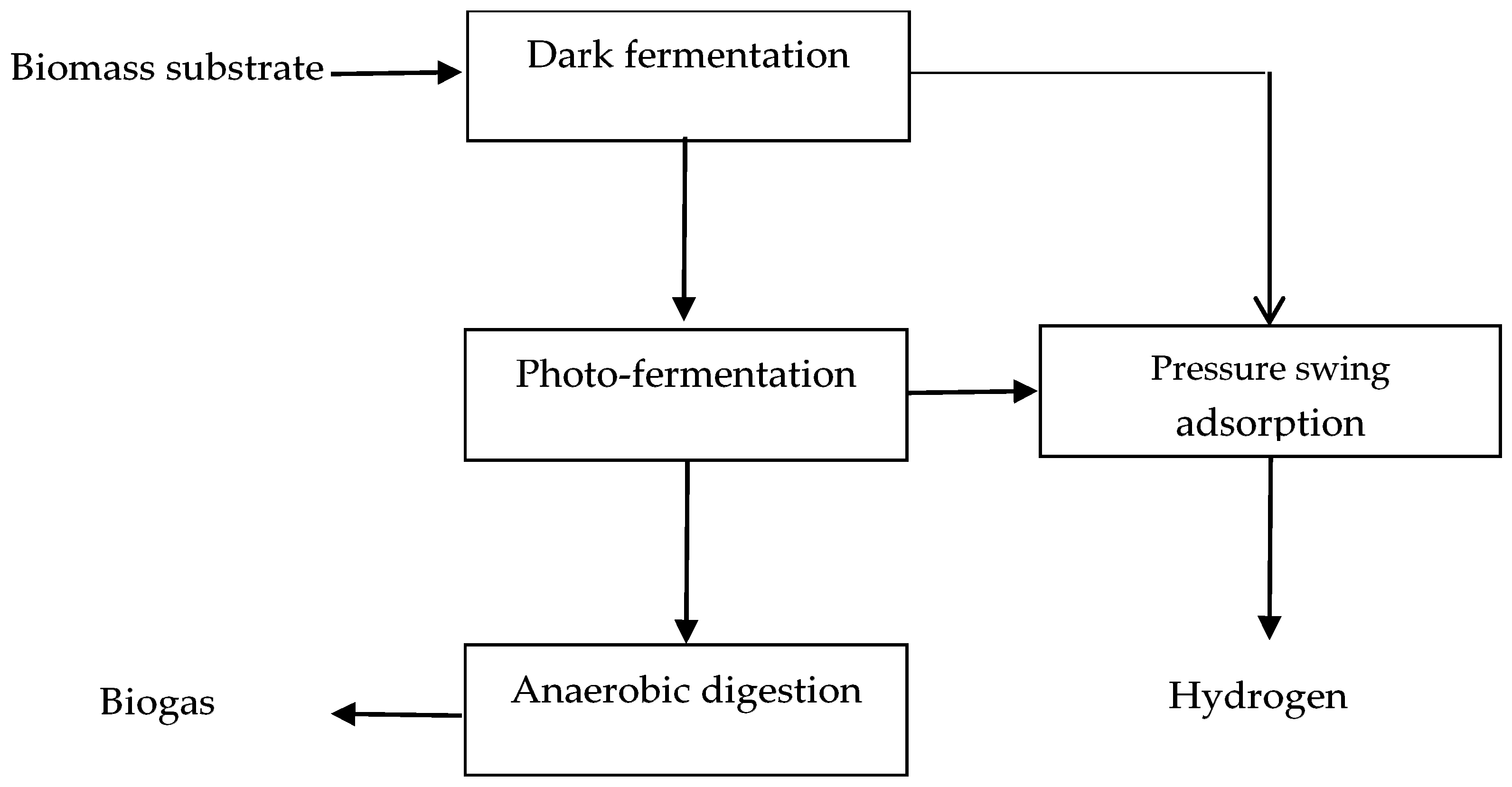

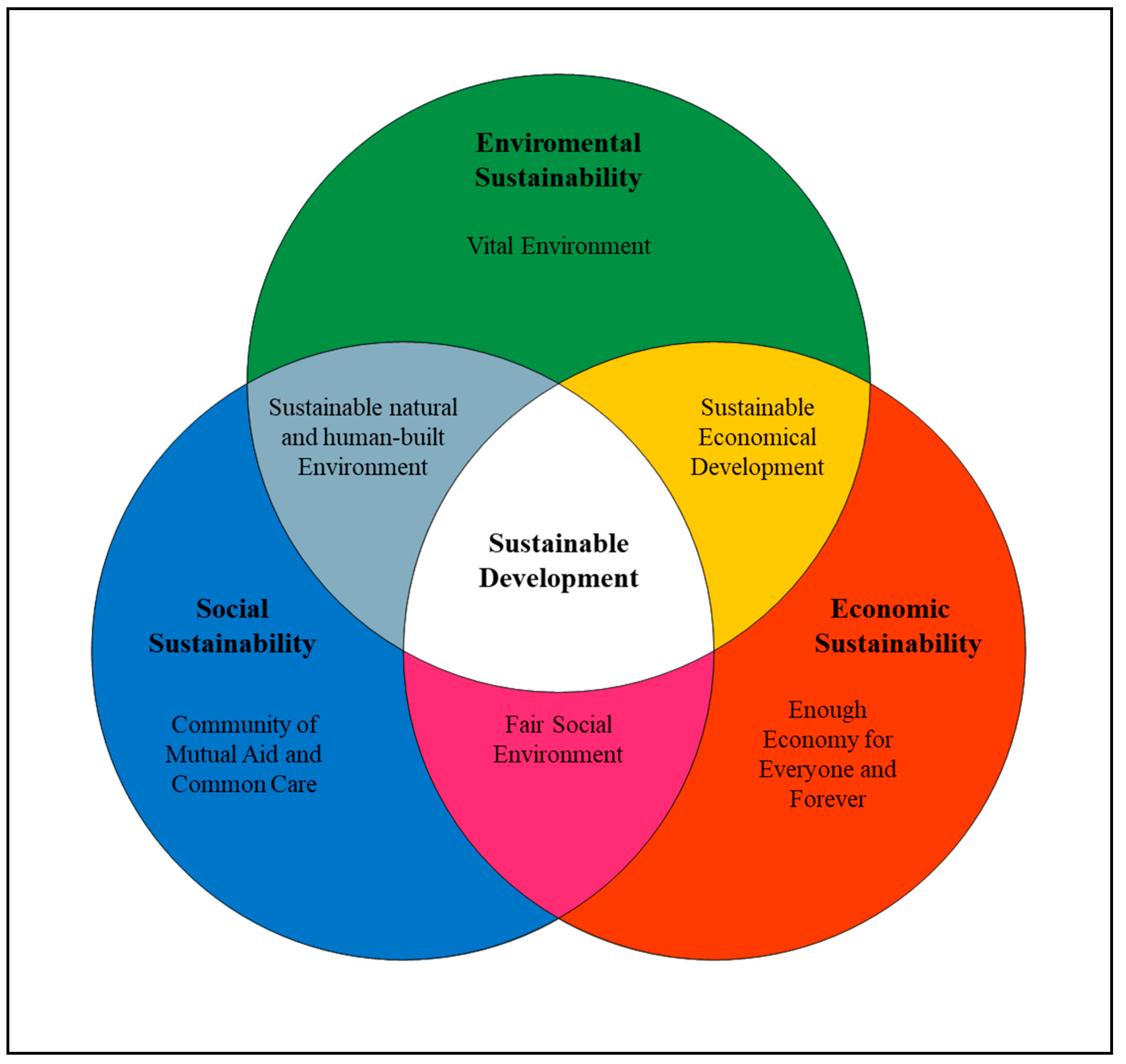
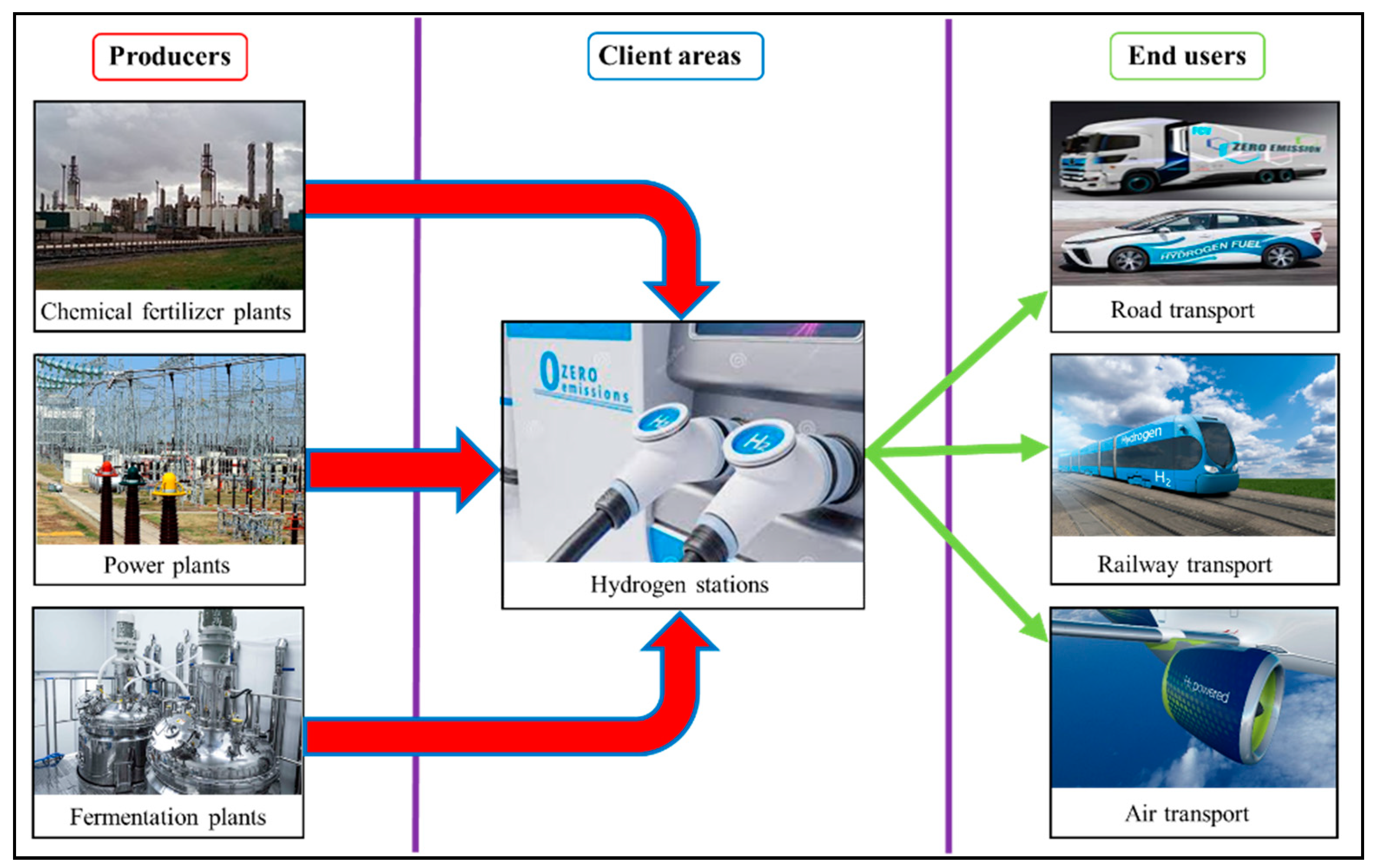
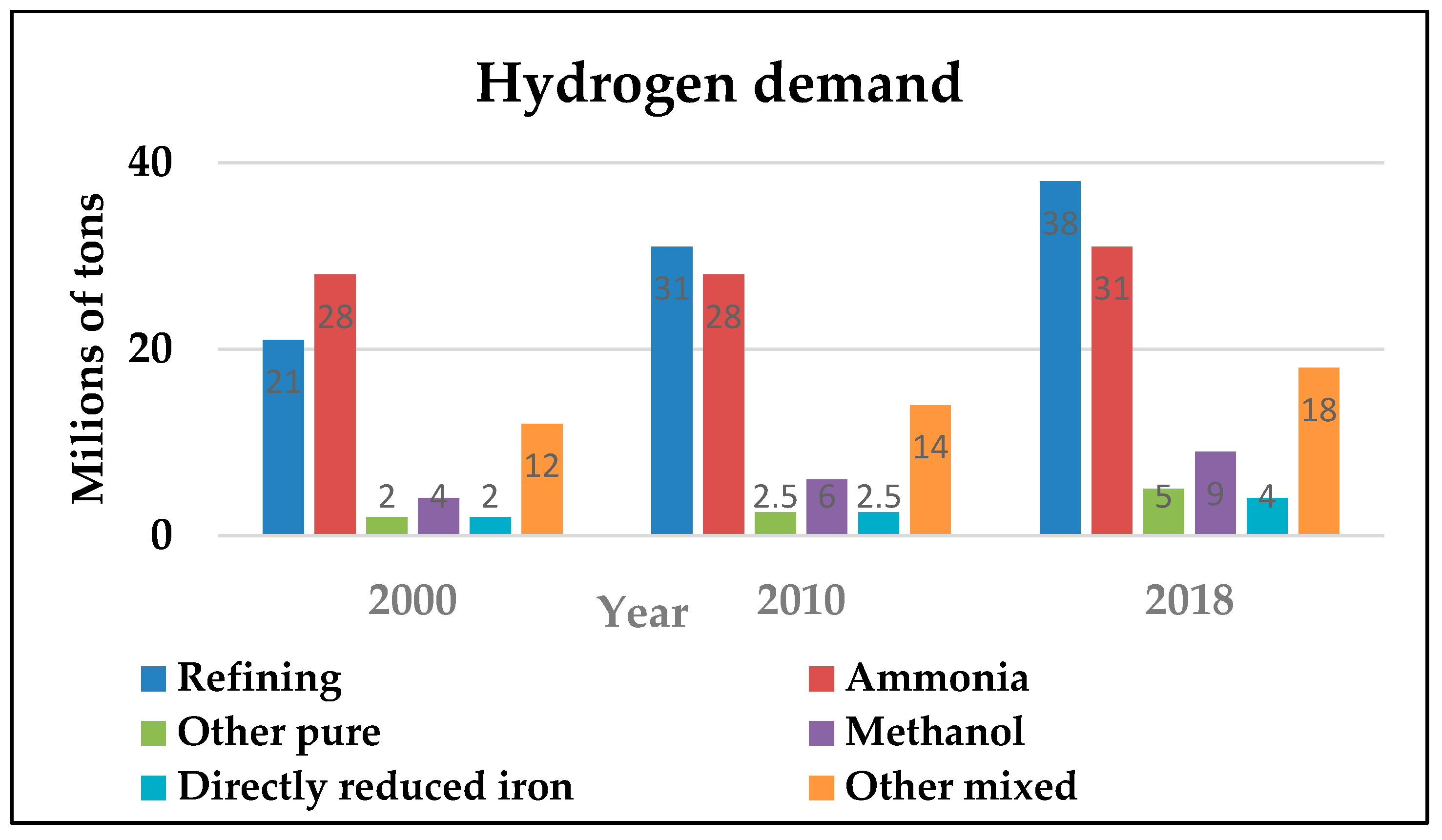
| Color | Method of Hydrogen Production | Advantages/Drawback |
|---|---|---|
| Green | Electrolysis, based on renewable energy sources or their combination (solar and wind power) | No greenhouse emissions. Expensive. |
| Blue | Steam reforming of methane with carbon dioxide capturing | Cheap with high productivity. Carbon dioxide release with subsequent capturing and storage. |
| Grey | Steam reforming of methane without carbon dioxide capturing | Cheap with high productivity. Carbon dioxide release. |
| Black/brown | Gasification of coal | Cheap, but with adverse impact on environment. |
| Pink | Electrolysis by nuclear power station electricity | Uses the surplus of produced electricity by nuclear power stations. |
| Turquoise | Catalytic methane pyrolysis with solid carbon as by-product | Process in development and still expensive. |
| Yellow | Electrolysis solely using solar energy | No greenhouse emissions. |
| Substrate | Anodic Potential vs. Ag/AgCl, V | Hydrogen Content in the Biogas, %vol. | Hydrogen Production Rate, m3 m−3 day−1 |
|---|---|---|---|
| Dairy industry | 0.8 | 76 | 0.086 |
| Food processing | 0.7 | 86 | 0.8–1.8 |
| Domestic wastewater | 1.1 | 100 | 0.015 |
| Method of Production | Non-Renewable Energy (kWh) Use per 1 Nm3 Hydrogen | Process Efficiency, % |
|---|---|---|
| Steam methane reforming | 4.66 | 64 |
| Dark fermentation | 1.52 | 9.6 |
| Photo-fermentation | 0.99 | 25.6 |
| Two-stage fermentation | 0.97 | 27.6 |
| Microbial electrolysis | 1.61 | 25.7 |
Disclaimer/Publisher’s Note: The statements, opinions and data contained in all publications are solely those of the individual author(s) and contributor(s) and not of MDPI and/or the editor(s). MDPI and/or the editor(s) disclaim responsibility for any injury to people or property resulting from any ideas, methods, instructions or products referred to in the content. |
© 2023 by the authors. Licensee MDPI, Basel, Switzerland. This article is an open access article distributed under the terms and conditions of the Creative Commons Attribution (CC BY) license (https://creativecommons.org/licenses/by/4.0/).
Share and Cite
Beschkov, V.; Ganev, E. Perspectives on the Development of Technologies for Hydrogen as a Carrier of Sustainable Energy. Energies 2023, 16, 6108. https://doi.org/10.3390/en16176108
Beschkov V, Ganev E. Perspectives on the Development of Technologies for Hydrogen as a Carrier of Sustainable Energy. Energies. 2023; 16(17):6108. https://doi.org/10.3390/en16176108
Chicago/Turabian StyleBeschkov, Venko, and Evgeniy Ganev. 2023. "Perspectives on the Development of Technologies for Hydrogen as a Carrier of Sustainable Energy" Energies 16, no. 17: 6108. https://doi.org/10.3390/en16176108
APA StyleBeschkov, V., & Ganev, E. (2023). Perspectives on the Development of Technologies for Hydrogen as a Carrier of Sustainable Energy. Energies, 16(17), 6108. https://doi.org/10.3390/en16176108







